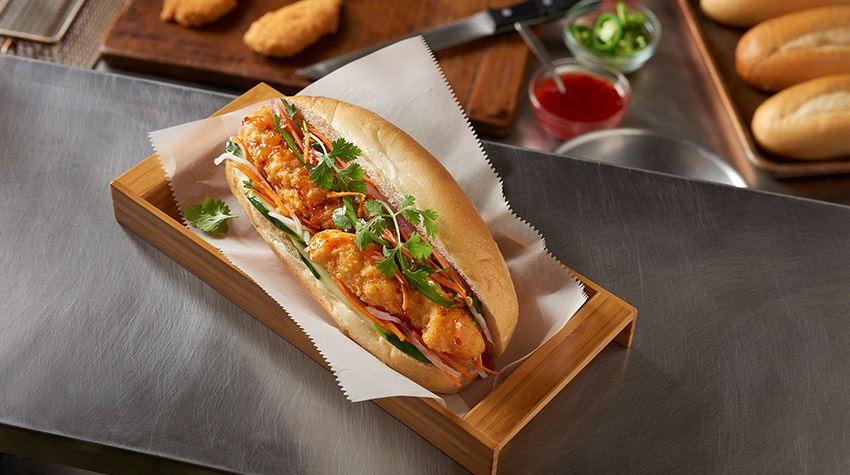5 Business-Building Ways to Embrace Evolving Ethnic Cuisines
Published on: 01/08/2019 in Culinary Trends
Published on: 01/08/2019 in Culinary Trends

Menus featuring global flavors provide restaurant patrons—including those at fast casual spots—with the opportunity to experiment. The new wave of fast-casual concepts is strikingly more ethnic than in the past.1 For restaurant operators, incorporating ethnic ingredients in creative ways is an image-making opportunity. You don’t have to change your menu to create a culinary culture that incorporates global flavors and piques customer interest. Here are suggestions for putting ethnic cuisines to work for you.
Start by adding a global note to menu favorites. According to Datassential research, Millennial customers, who make up 25 percent of the U.S. population, are most likely to experiment and embrace ethnic flavors. Nearly half will try a new food simply because it sounds interesting.1 Tweak existing menu items to unlock new flavor experiences for customers. Creative spins might include gochujang–basted chicken wings or roasted chicken paired with Indian-inspired yellow curry sauce. Flavor-packed condiments interject new flavor notes, too. Think ponzu dipping sauce, Indonesian sambal, or chicken sandwich spreads featuring miso mayo.
Popular Pan Asian cuisines have evolved, and today include Korean and Filipino inspirations.2 Datassential reports that Korean ingredients, for example, are now mentioned on 5.2 percent of all menus, a 71-percent increase since 2013.3 Hawaiian-inspired ethnic specialties are also gathering momentum in the continental U.S. According to Datassential MenuTrends4, 15 percent of menus now feature the term “Hawaiian,” representing an increase of 5 percent in the last year. Hawaiian specialties include poi (fermented taro root), lilikoi (passion fruit) and common Hawaiian entrees like chicken long rice, made with cellophane noodles.5
Global versions of one-bowl meals offer a chance to give popular proteins a fresh accent, with everything from Puerto Rican-inspired sofrito chicken stew to Indian-influenced tandoori turkey. LYFE Kitchen in Chicago offers modern comfort cuisine with globally influenced ingredients. The restaurant’s spicy chicken and black bean bowl combines black rice, sautéed peppers, quinoa, cheddar and avocado.6
Promote the healthful aspects of your own menu—whether you’re featuring ingredients such as organic chicken or turkey with no antibiotics ever, or a range of better-for-you options.
Keeping up with evolving global flavor trends doesn’t have to be difficult. Mix-and-match customization is simplified when you focus on popular ingredients like chicken. The fast-casual Bibibop Asian Grill, a 29-unit bibimbap chain based in Columbus, Ohio, features Korean bowls with a choice of four proteins.7 Two of the protein options are chicken and spicy chicken; patrons customize their orders with their preference of rice or noodles, toppings, and sauces.8
Fusions that pair emerging ethnic flavors with familiar presentations are another way to create customer buzz. For instance, St. Louis-based Seoul Taco presents its Korean flavors in familiar Mexican forms like burritos, quesadillas and nachos, loaded with ingredients such as kimchi fried rice and Seoul sauces.9
Environmental responsibility and sustainability have global impact. If your restaurant sources clean-label ingredients, make sure your customers know about it.10 According to Datassential, 88% of consumers also are likely to show support when they know a food company’s values reflect their own.11 Among Millennials, the term “humanely raised” is the top descriptor.12 Pret a Manger, an international company with 90 locations in several U.S. cities, is committed to sustainability and improving animal welfare.13 Among its menu specialties is the balsamic chicken and avocado sandwich featuring chargrilled antibiotic-free chicken.
1 Datassential, FoodBytes, Feb. 2018, “Millennial SNAP! Keynote Report”
5 Restaurant Hospitality, 6 Korean Fast Casual Chains RH 5/17/2018
7 Restaurant Hospitality: 6 Korean Fast Casual Chains RH 5/17/2018
10 National Restaurant Association release, “Marketing to Millennials”
11 Datassential FoodBytes, September 2018
12 Datassential, FoodBytes, Feb. 2018, Millennial SNAP! Keynote Report, “10 Inception-Level Descriptors”